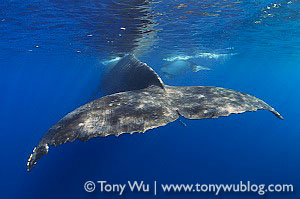 So much has happened in the past several days that it's difficult to know where to begin.
So much has happened in the past several days that it's difficult to know where to begin.
The first group of visitors from Japan who came to swim with the whales with my friend Takaji and me has come and gone, and a second group is due to arrive soon. Arranging all the logistics is a lot of work (Murphy's Law seems to be the most well enforced law in Tonga), but it's great to see so many happy faces at the end of the day.
Contrary to popular media depiction, most people in Japan have never eaten and/ or have no desire to consume whale. A very small portion of the Japanese government seems relentless in its pursuit of the commercial whaling agenda, but that position does not represent the views of most people in Japan.
The specific motives of the people involved with this issue are subject to interpretation and debate, but the impetus behind their actions most certainly is not a function of representing the will of the nation's people.
It seems in the self-interest of mass media, some politicians and many NGOs to depict Japan as a nation of insensitive, whale-killing barbarians, but the truth is that most people in Japan would much rather pay to see whales alive than eat them...just like most people everywhere else in the world.
Some proof of this is the immense interest we get each year from people in Japan wanting to visit Tonga and other cetacean hotspots around the world. I could ramble on for hours and hours about the reasons that mass media stories on this subject are almost entirely poorly researched, intentionally inflammatory yellow journalism, but it's probably best to save that for another time...
Baby Talk
I've now documented three more humpback babies (in addition to Hina Hina), for a total of four this season. It's the lowest number I've seen.
I found the second baby last Tuesday, almost as soon as we left the harbour...mother, calf and escort. We were obviously overjoyed with finding a second mother/ calf pair, but having an escort around is a mixed blessing.
 Generally, the presence of an escort means that there's greater activity. The escort keeps things moving, preventing the mom and baby from resting too often, which makes in-water encounters relatively difficult.
Generally, the presence of an escort means that there's greater activity. The escort keeps things moving, preventing the mom and baby from resting too often, which makes in-water encounters relatively difficult.
While this isn't always the case, unfortunately it was in this instance. We tracked the trio for more than an hour, finally parting ways when they had headed well out to sea in the general direction of Fiji.
To cut a long story short, I was quite surprised and happy when we found the same mom/ calf/ escort group in a different location about five hours later. Again, we weren't able to swim with them, but with the three hours or so in total that we spent near the group, we were able to observe a lot of different behaviours.
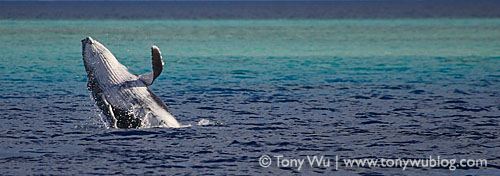 The calf's dorsal fin looked as if it had been sliced off at the top...not literally...it's just a natural variation in dorsal fin shape. For obvious reasons, I've nicknamed it "Stumpy". Not quite as cute as "Hina Hina", but certainly easy to remember.
The calf's dorsal fin looked as if it had been sliced off at the top...not literally...it's just a natural variation in dorsal fin shape. For obvious reasons, I've nicknamed it "Stumpy". Not quite as cute as "Hina Hina", but certainly easy to remember.
The second baby came the following day, far out to sea. It was an unusually calm day, and we headed out further than I've ever been before. The entire Vava'u island group was but a hazy mirage on the horizon.
Out in the blue wilderness, another boat being driven by a friend had found a mother, calf and three(!) escorts. Besides the considerable distance from land, there are two other things that make this encounter noteworthy.
First, it's not unusual to encounter one or even two escorts, but three is less common. The instances I specifically recall having three escorts was in 2003 and once last year. I have a really good photo of the five whales together in the water from 2003, but unfortunately don't have it with me.
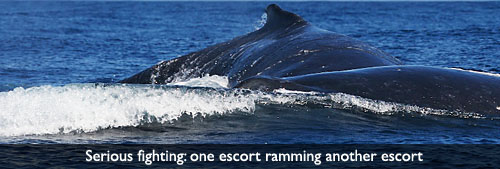 In this instance, the three escorts were so hyperactive that again, we weren't able to get into the water. Watching the display from the boat was absolutely fascinating though.
In this instance, the three escorts were so hyperactive that again, we weren't able to get into the water. Watching the display from the boat was absolutely fascinating though.
Bulls popping up like submarines executing an emergency ascent; whales charging headfirst into other whales; escorts snorting and blowing bubbles furiously as they exchanged spent air in their lungs for fresh, oxygen-rich gas to continue their underwater battles; 50-tonne behemoths making sharp U-turns and sending violent eddies in all directions...words fail to convey the scale and pace of action.
Second, seeing escorts compete this hard for females is relatively more common later in the season (when the number of available single females has decreased). It's still early in the humpback season here, so finding three healthy males competing for a mother with a calf (as opposed to competing for a breeding-age female without a calf) seems unusual. The image I took of a mom, calf and three escorts in 2003 was from the second-half of September, much later in the season.
In any case, there they were...all five whales heading further and further south. Many times, mom and baby looked as if they wanted to stop for a rest, but each time they paused, the three randy bulls cajoled them back into motion.
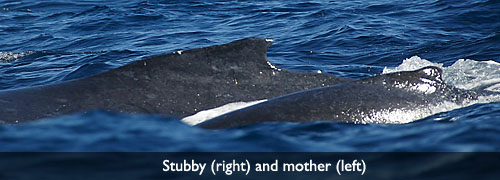 The baby in this instance also seemed to have a truncated dorsal fin, though slightly different from Stumpy. I nicknamed it "Stubby"...calf number three of the season.
The baby in this instance also seemed to have a truncated dorsal fin, though slightly different from Stumpy. I nicknamed it "Stubby"...calf number three of the season.
The fourth and final calf is one that another boat found in North Bay. This mother and baby had no escorts associated with them, and the mother was quite large. Most notably, however, the mother wasn't keen on having people in the water.
She had an unusual habit of hanging upside-down in the water with just her tail sticking out. I've seen other whales do this before, but not a mother with a calf. Identifying this mom is easy because of the peculiar habit she has, and also because of the unique V-shape cut on the left-side of her fluke. I've named her "Veronica" for the V. (The calf doesn't seem to have any easily identifiable marks in this instance, or at least none I was able to discern.)
 Veronica seemed to be fine with having boats around, but as soon as she sensed anyone in the water, she'd dive slowly into the deep and reappear a few hundred metres away.
Veronica seemed to be fine with having boats around, but as soon as she sensed anyone in the water, she'd dive slowly into the deep and reappear a few hundred metres away.
In addition, the weather was rough with winds gusting at least 20 knots, so we managed one look at her and the calf underwater, but otherwise left her alone.
No F*cking Excuse
 Back on land, I've sort of adopted an abandoned golden retriever who's living on the dock that we depart from each morning. It's a male, probably 5-7 years old or so, though it's difficult to be certain, and it has a wonderful disposition...as golden retrievers generally do.
Back on land, I've sort of adopted an abandoned golden retriever who's living on the dock that we depart from each morning. It's a male, probably 5-7 years old or so, though it's difficult to be certain, and it has a wonderful disposition...as golden retrievers generally do.
When we arrived, it was all skin-and-bones, on the brink of starving to death. Seeing it reminded me of the photos of Nazi concentration camp victims and brought a lump to my throat.
The dog's owners had obviously left it to fend for itself, which for a golden retriever is practically a death sentence. After asking around a bit, I've determined that it most likely belonged to some of the people who own/ run Beluga Divers. The couple concerned apparently parted ways (with the wife going to New Zealand), and this dog was abandoned weeks ago.
I've been feeding the dog, and enlisting the help of others to do so too. In recent days, it's become much healthier, and now responds to my whistle and has enough energy to greet me and other people, and also to wag its tail.
Though seeing the dog recover some health and energy is gratifying, I'm trying to find someone here to adopt it before I leave Tonga. It's such a beautiful dog. I hate to think what will happen to it once we leave.
There's simply no excuse for abandoning this dog.
Trial by Fire
 There was an incredibly large fire a couple of nights ago around 6pm, on Pangaimotu island, which lies directly across Neiafu harbour from where we're staying. I was sitting at a restaurant ordering dinner when it started. At first, we saw a lot of smoke rising from the hills across the harbour, but didn't think too much of it because people burn trash and other things here all the time.
There was an incredibly large fire a couple of nights ago around 6pm, on Pangaimotu island, which lies directly across Neiafu harbour from where we're staying. I was sitting at a restaurant ordering dinner when it started. At first, we saw a lot of smoke rising from the hills across the harbour, but didn't think too much of it because people burn trash and other things here all the time.
Once flames started to leap over the top of the hills though, we realised things were out of control. Strong winds fanned the flames, and I thought the fire might continue through the night, possibly beyond. At one point, the flames were so strong that they lit up the night sky like orange lights from a football stadium.
Fortunately, however, the blaze was brought under control within a couple of hours. Turns out that the fire had been set intentionally to clear away land for crops. Whoever set the fire obviously didn't stop to consider the potential effect of 20-knot gusts, which ended up first carrying the flames beyond the planned burn zone, and then fueling the fire 'til the situation went out of control.
I'm not sure if anyone was injured, but I sure hope the people concerned learned a valuable lesson.
Other Cetacean Stuff
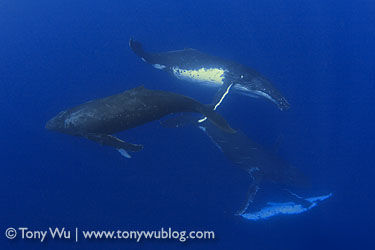 On the day we found Stubby, we also had some great swims among a group of four whales engaged in a semi-heat run. The action wasn't as intense as a full-on heat run situation, but active enough to keep us swimming hard.
On the day we found Stubby, we also had some great swims among a group of four whales engaged in a semi-heat run. The action wasn't as intense as a full-on heat run situation, but active enough to keep us swimming hard.
The four seemed to be divided into two pairs that pretty much stayed together the entire time. Whether the two pairs were breeding pairs or males I'm not sure, but from their behaviour, I'd speculate we had two male/ female pairs.
We left the four to another boat with friends on it, and later learned that other whales joined the original four some time after we left, and at one point, there were a total of nine or so whales around.
Though everyone loves encounters with mothers with baby whales, I personally have come to prefer encounters like this, with groups of whales moving at high speed. There's much more activity to keep track of, and there's a great deal of whale-to-whale interaction to observe...from fights, to apparent friendships and even courting behaviour.
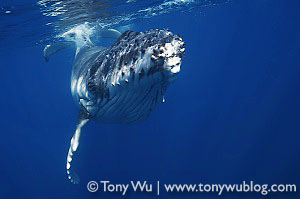 Following whales like this is much more demanding though. Boat captains have to really know their stuff, and once you're in the water, you've got to keep up with the whales...which is no easy task, to severely understate the point.
Following whales like this is much more demanding though. Boat captains have to really know their stuff, and once you're in the water, you've got to keep up with the whales...which is no easy task, to severely understate the point.
Hina Hina has become somewhat of a local celebrity this season, given the mom and baby's propensity to interact with people in the water. All the boats now know about and look for Hina Hina.
Hina Hina's mom is exceptionally large, so we've also given her a nickname..."Big Momma". She's one of the largest females I've ever seen.
We've found the friendly duo a few more times in the past week or so. They've covered a wide area, showing the extent to which the mom has been exercising Hina Hina, no doubt to prepare the energetic young whale for the upcoming long journey back to feeding grounds down south.
 We also had dozens, if not hundreds, of small spinner dolphins around us for much of one morning. They're always a delight, with their love of bow-riding and acrobatic, spinning leaps into the air, for which they're named. I've yet to nail a perfect photo of one of their twirling jumps....someday.
We also had dozens, if not hundreds, of small spinner dolphins around us for much of one morning. They're always a delight, with their love of bow-riding and acrobatic, spinning leaps into the air, for which they're named. I've yet to nail a perfect photo of one of their twirling jumps....someday.
Finally, still haven't seen any whales with all-white pectoral fins, a stark contrast to last season.
Today is a day off. Though I'd love to be out on the water, I need a day to recover. The pounding we endure out there takes its toll, so a dry day every now and then is an absolute must.